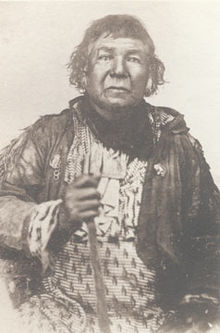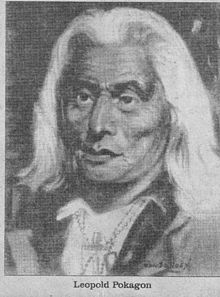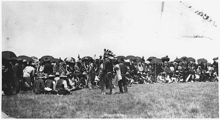Potawatomi
| Regions with significant populations | |
|---|---|
| Michigan, Wisconsin, Oklahoma, United States; Ontario, Canada | |
| Languages | |
| English, Potawatomi | |
| Religion | |
| Catholicism, Methodism, Midewiwin | |
| Related ethnic groups | |
| Ottawa and Ojibwe |
The Potawatomi /ˌpɑːtəˈwɑːtəmiː/,[1] also spelled Pottawatomie and Pottawatomi (among many variations), are a Native American people of the upper Mississippi River region. They traditionally speak the Potawatomi language, a member of the Algonquian family. In the Potawatomi language, they generally call themselves Bodéwadmi, a name that means "keepers of the fire" and that was applied to them by the Ojibwe. They originally called themselves Neshnabé, a cognate of the word Anishinaabe. The Potawatomi were part of a long-term alliance, called the Council of Three Fires, with the Ojibwe/Jibwe (Chippewa) and Odaawaa/[O]dawa (Ottawa). In the Council of Three Fires, the Potawatomi were considered the "youngest brother."
Name
The English "Potawatomi" is derived from the Ojibwe Boodewaadamii(g) (syncoped in the Ottawa as Boodewaadmii(g)). The Potawatomi's name for themselves (autonym) is Bodéwadmi (without syncope: Bodéwademi; plural: Bodéwadmik), a cognate of the Ojibwe form. Their name means "those who keep/tend the hearth-fire," which refers to the hearth of the Council of Three Fires. The word comes from "to keep/tend the hearth-fire," which is bodewadm (without syncope: bodewadem) in the Potawatomi language; the Ojibwe and Ottawa forms are boodawaadam and boodwaadam, respectively.
Alternatively, the Potawatomi call themselves Neshnabé (without syncope: Eneshenabé; plural: Neshnabék), a cognate of Ojibwe Anishinaabe(g), meaning "Original People".
History

The Potawatomi are first mentioned in French records, which suggest that in the early 17th century, they lived in what is now southwestern Michigan. During the Beaver Wars they fled to the area around Green Bay to escape attacks by both the Iroquois and the Neutral Nation, who were seeking expanded hunting grounds.
As an important part of Tecumseh's Confederacy, Potawatomi warriors took part in Tecumseh's War, the War of 1812 and the Peoria War. Their allegiance switched repeatedly between the British and the Americans as power relations shifted between the nations.
At the time of the War of 1812, a band of Potawatomi inhabited the area near Fort Dearborn, in the current location of Chicago. Led by the chiefs Blackbird and Nuscotomeg (Mad Sturgeon), a force of about 500 warriors attacked the evacuation column leaving Fort Dearborn; they killed a majority of the civilians and 54 of Captain Nathan Heald's force, and wounded many others. George Ronan, the first graduate of West Point to become a fatal casualty in combat, was killed in this ambush. The incident is referred to as the Battle of Fort Dearborn. A Potawatomi chief named Mucktypoke (Makdébki, Black Partridge), counseled against the attack and later saved some of the civilian captives who were being ransomed by the Potawatomi.[2]
The Prairie Band Potawatomi purchased 1,280 acres (5.2 km2) of land near Shabbona, Illinois, in rural DeKalb County.[3] The Mesquaki, another Algonquian people, also bought land in Illinois, one of the only states that allowed Indians to purchase land. Another band of the Potawatomi had land in Crown Point, Indiana.
Today, the Potawatomi are a thriving community, building their community in Southwestern Michigan (Dowagiac). They provide health services and education to the people, with revenues generated from the tribe's gaming and other business operations[citation needed].
Leaders
French period (1615–1763)
The French period of contact began with early explorers who reached the Potawatomi in western Michigan. They also found the tribe located along the Door Peninsula of Wisconsin. By the end of the French period, the Potawatomi had begun a move to the Detroit area, leaving the large communities in Wisconsin.[2]
- Madouche during the Fox Wars
- Millouisillyny
- Onanghisse (Wnaneg-gizs "Shimmering Light") at Green Bay
- Otchik at Detroit
English period (1763–1783)
The British period of contact began when France ceded its lands after the defeat in the French and Indian War (aka Seven Years' War). Pontiac's Rebellion was an attempt by Native Americans to push the British and other European settlers out of their territory. The Potawatomi captured every British frontier garrison but the one at Detroit.[2]
The Potawatomi nation continued to grow and expanded westward from Detroit, most notably in the development of the St. Joseph villages adjacent to the Miami in southwestern Michigan. The Wisconsin communities continued and moved south along the Lake Michigan shoreline.[2]
- Nanaquiba (Water Moccasin) at Detroit
- Ninivois at Detroit
- Peshibon at St. Joseph
- Washee (from Wabzi, "the Swan") at St. Joseph during Pontiac's Rebellion
United States treaty period (1783–1830)
The United States Treaty period of Potawatomi history began with the Treaty of Paris (1783), which ended the American Revolutionary War and established the United States' interest in the lower Great Lakes. It lasted until the treaties for Indian Removal were signed. The US recognized the Potawatomi as a single tribe. They often had a few tribal leaders whom all villages accepted. The Potawatomi had a decentralized society, with several main divisions based on geographic locations: Milwaukee or Wisconsin area, Detroit or Huron River, the St. Joseph River, the Kankakee River, Tippecanoe and Wabash Rivers, the Illinois River and Lake Peoria, and the Des Plaines and Fox Rivers.
The chiefs listed below are grouped by geographic area.
Milwaukee Potawatomi
Chicago Potawatomi
- Billy Caldwell,[2] also known as Sauganash (Zhaaganaash: "Englishman") (1780–1841)
Des Plaines and Fox River Potawatomi
- Aptakisic (fl. 1830s) (Abtagizheg "Half Day")[4]
- Mukatapenaise (Mkedébnés "Blackbird")[2]
- Waubansee (He Causes Paleness)[2]
- Waweachsetoh[2] along with La Gesse, Gomo or Masemo (Resting Fish)
Illinois River Potawatomi

- Mucktypoke[2] (Makdébki: "Black Partridge")
- Senachewine[2] (d. 1831) (Petacho or Znajjewan "Difficult Current") was the brother of Gomo who was chief among the Lake Peoria Potawatomi
Kankakee River (Iroquois and Yellow Rivers) Potawatomi
- Main Poc,[2] also known as Webebeset ("Crafty One")
- Micsawbee[5] 19th century
- Notawkah[2] (Rattlesnake) on the Yellow River
- Nuscotomeg[2] (Neshkademég, "Mad Sturgeon") on the Iroquois and Kankakee Rivers
- Mesasa (Mezsézed, "Turkey Foot")[2]
St. Joseph and Elkhart Potawatomi
- Chebass[2] (Zhshibés: "Little Duck") on the St. Joseph River
- Five Medals (Wa-nyano-zhoneya: "Five-coin")[2] on the Elkhart River
- Onaska[5] on the Elkhart River
- Topinbee (He who sits Quietly) (??-1826)[2]
Tippecanoe and Wabash River Potawatomi
- Aubenaubee[2][5] (1761–1837/8) on the Tippecanoe River
- Askum[2] (More and More) on the Eel River
- George Cicott[5] (1800?–1833)
- Keesass on the Wabash River
- Kewanna[5] (1790?–1840s?) (Prairie Chicken) Eel River
- Kinkash[2] (see Askum)
- Magaago
- Monoquet[2][5] (1790s–1830s) on the Tippecanoe River
- Tiosa[5] on the Tippecanoe River

Metea - Winamac (Winmég, "Catfish")[5]—allied with the British during the War of 1812
- Winamac (Winmég, "Catfish")[5]—allied with the Americans during the War of 1812
Fort Wayne Potawatomi
American removal period (1830–1840)
The removal period of Potawatomi history began with the treaties of the late 1820s when the United States created reservations. Billy Caldwell and Alexander Robinson negotiated for the United Nations of Chippewa, Ottawa and Potowatomi in the Treaty of Praire du Chien of 1829, by which they ceded most of their lands in Wisconsin and Michigan. Some Potawatomi became religious followers of the "Kickapoo Prophet", Kennekuk. Over the years, the US reduced the reservations under pressure for land by migrating European Americans.
The final step followed the Treaty of Chicago, negotiated in 1833 for the tribes by Caldwell and Robinson. It was the US forced removal of the Illinois Potawatomi to Nebraska and the Indiana Potawatomi to Kansas, both west of the Mississippi River. The removal of the Indiana Potawatomi was documented by a Catholic priest, Benjamin Petit, who accompanied the Indians on the Potawatomi Trail of Death. Petit died while returning to Indiana. His diary was published by the Indiana Historical Society in 1941.
Many Potawatomi found ways to remain, primarily those in Michigan, and others fled to their Odawa neighbors or Canada to avoid removal.
- Iowa, Wabash River
- Maumksuck (Mangzed, "Big Foot") at Lake Geneva
- Mecosta (Mkozdé, "Having a Bear's Foot")

- Chief Menominee (1791?–1841) Twin Lakes of Marshall County
- Pamtipee of Nottawasippi
- Mackahtamoah (Mkedémwi, "Black Wolf") of Nottawasippi
- Pashpoho of Yellow River near Rochester, Indiana
- Pepinawah
- Leopold Pokagon (c. 1775–1841)
- Simon Pokagon (c. 1830-1899)
- Alexander Robinson (Chechepinquay (Jchebingwé, "Squinter"[6])) (??–1872)
- Sauganash (Billy Caldwell), removed his band ultimately to what would become Council Bluffs, Iowa in 1838, where they lived at what was known as Caldwell's Camp. Father Pierre-Jean De Smet established a mission there that was active 1837-1839.
- Shupshewahno (19th century–1841) or Shipshewana (Vision of a Lion) at Shipshewana Lake.[7]
- Topinbee (The Younger) on the St. Joseph River
- Wabanim (Wabnem, "White Dog") on the Iroquois River
- Michicaba (Snapping Turtle) on the Iroquois River
- Wanatah
- Weesionas (see Ashkum)
- Wewesh
Bands


There are several active bands of Potawatomi.
- United States
Federally recognized Potawatomi tribes in the United States:
- Citizen Potawatomi Nation, Oklahoma
- Forest County Potawatomi Community, Wisconsin;
- Hannahville Indian Community, Michigan;
- Match-E-Be-Nash-She-Wish Band of Pottawatomi (also known as the Gun Lake tribe), based in Dorr, Michigan in Allegan County, Michigan;
- Nottawaseppi Huron Band of Potawatomi, based in Calhoun County, Michigan;
- Pokagon Band of Potawatomi Indians, Michigan and Indiana; and
- Prairie Band of Potawatomi Nation, Kansas.
- Canada
- Chippewas of Nawash Unceded First Nation, Bruce Peninsula, Ontario;
- Saugeen First Nation, Ontario;
- Chippewas of Kettle and Stony Point, Ontario;
- Moose Deer Point First Nation, Ontario
- Walpole Island First Nation on an unceded island between the United States and Canada
- Wasauksing First Nation, Parry Island, Ontario
Population
| Year | Total | United States |
Canada |
|---|---|---|---|
| 1667[8] | 4,000 | ||
| 1765[9] | 1,500 | ||
| 1766[9] | 1,750 | ||
| 1778[9] | 2,250 | ||
| 1783[9] | 2,000 | ||
| 1795[9] | 1,200 | ||
| 1812[9] | 2,500 | ||
| 1820[9] | 3,400 | ||
| 1843[9] | 1,800 | ||
| 1854[8] | 4,440 | 4,040 | 400 |
| 1889[10] | 1,582 | 1,416 | 166 |
| 1908[9] | 2,742 | 2,522 | 220 |
| 1910[8] | 2,620 | 2,440 | 180 |
| 1990[11] | 23,000 | 17,000 | 4,000 |
| 1997[12] | 25,000 | ||
| 1998[8] | 28,000 |
Clans
Chauvignerie (1736) and Morgan (1877) mentions among the Potawatomi doodems (clans) being:
|
|
|
Location

The Potawatomi first lived in lower Michigan, then moved to northern Wisconsin and eventually settled into northern Indiana and central Illinois. In the early 19th century, major portions of Potawatomi lands were seized by the U.S. government. Following the Treaty of Chicago in 1833, most of the Potawatomi people were forcibly removed from the tribe's lands. Many perished en route to new lands in the west through Iowa, Kansas and Oklahoma, following what became known as the "Trail of Death".
| Year or Century | Location[13] |
|---|---|
| 1615 | East of Michilimackinac, MI |
| Islands of Door Peninsula, WI (1st Fr) | |
| 1640 | (until) with Hochunk (Winnebago) west of Green Bay, WI |
| 1641 | Sault Ste. Marie, MI |
| 1670 | Mouth of Green Bay, WI/MI |
| 17th century | Milwaukee River, WI |
| 1780s | on St. Joseph River, MI/IN |
Language
Potawatomi (also spelled Pottawatomie; in Potawatomi Bodéwadmimwen or Bodéwadmi Zheshmowen or Neshnabémwen) is a Central Algonquian language and is spoken around the Great Lakes in Michigan and Wisconsin, as well as in Kansas and in southern Ontario.[14] There are fewer than 1300 people who speak Potawatomi as a first language, most of them elderly.[15] There is currently an effort underway to revitalize the language.
The Potawatomi language is most similar to the Odawa language; however, it also has borrowed a considerable amount of vocabulary from Sauk. Like the Odawa language, or the Ottawa dialect of the Anishinaabe language, the Potawatomi language exhibits a great amount of vowel syncope.
Many places in the Midwest have names derived from the Potawatomi language, including Allegan, Waukegan, Muskegon, Oconomowoc, Pottawattamie County, and Skokie.
See also
- Cherokee Commission (allotment of Cherokee Outlet reservation)
- Potawatomi Trail of Death
- Treaty with the Potawatomi
- Theresa Marsh
Notes
- ^ Clifton, James A. (1978) "Potawatomi." In Northeast, ed. Bruce G. Trigger. Vol. 15 of Handbook of North American Indians, ed. William C. Sturtevant. Washington, D.C.: Smithsonian Institution, pg. 725
- ^ a b c d e f g h i j k l m n o p q r s t u v w x Edmunds, R. David (1988). The Potawatomis: Keepers of the Fire. Norman, OK: University of Oklahoma Press (Civilization of the American Indian Series). ISBN 0-8061-2069-X
- ^ http://www.chicagotribune.com/news/local/chicago/chi-0605100248may10,1,2459253.story
- ^ http://lakecountyhistory.blogspot.com/2011/03/aptakisic-half-day.html
- ^ a b c d e f g h i j k McPherson, Alan (1993). Indian Names in Indiana.
- ^ "Squinter" is a type of polarized snow goggles that is completely darkened, with one very narrow horizontal "squinter" slit in each lens area, allowing the wearer to clearly see without the glare from a reflection off snow, ice and water. Usually, these sunglasses were associated with the Inuit.
- ^ Dunn, Jacob Piatt (1908). True Indian Stories
- ^ a b c d Google archives of Sultzman, Lee. (December 18, 1998). "Potawatomi History" at www.tolatsga.org
- ^ a b c d e f g h i Hodges, Frederick Webb (1908). "Potawatomi" in Handbook of American Indians North of Mexico
- ^ "Linguistic Families of America" in Seventh Annual Report of the Bureau of Ethnology to the Secretary of the Smithsonian Institution, 1885-1886, Government Printing Office, Washington, 1891
- ^ "Potawatomi" at www.firstnationsseeker.ca
- ^ Ethnologue: Potawatomi
- ^ Kubiak, William J. (1970). Great Lakes Indians: A Pictorial Guide. Baker Book House Company.
- ^ Moseley, Christopher (2007). Encyclopedia of the World's Endangered Languages, p. 74. Routledge. ISBN 0-7007-1197-X.
- ^ Hinton, Leanne and Hale, Kenneth (2001). The Green Book of Language Revitalization in Practice, p. 342. Emerald Group Publishing. ISBN 0-12-349353-6.
External links
- Herbermann, Charles, ed. (1913). . Catholic Encyclopedia. New York: Robert Appleton Company.
- Hannahville Indian Community; Wilson, MI
- Citizen Potawatomi Nation, official website
- First Nations Compact Histories: Potawatomi History
- Forest County Potawatomi
- Kettle & Stony Point First Nation
- Match-E-Be-Nash-She-Wish Band of Pottawatomi (Gun Lake)
- Moose Deer Point First Nation
- Nottawaseppi Huron Band of Potawatomi
- Pokagon Band of Potawatomi Indians
- Potawatomi Author Larry Mitchell
- Prairie Band Potawatomi Nation
- Treaties with the Potawatomi
- Treaty Between the Ottawa, Chippewa, Wyandot, and Potawatomi Indians

